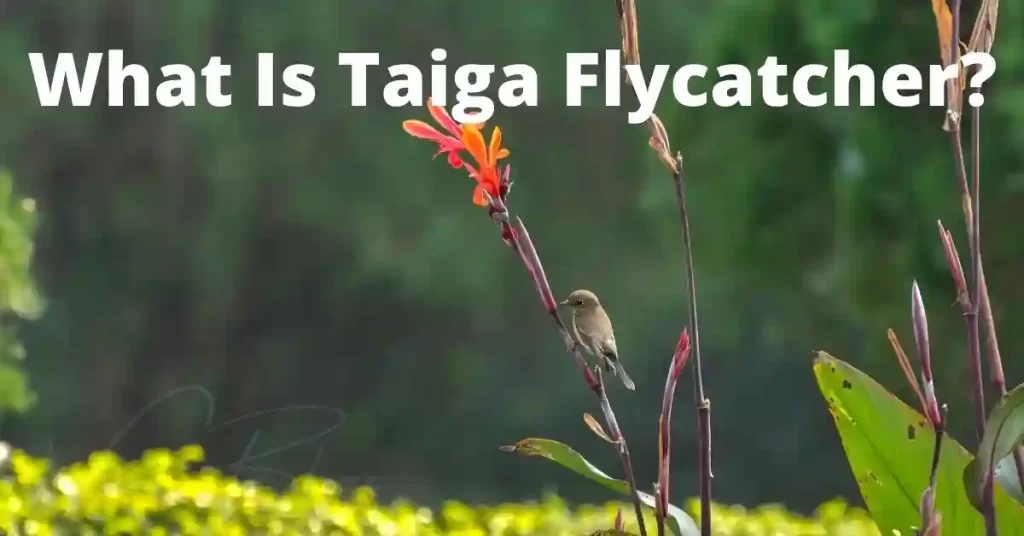The taiga flycatcher is a fantastic forest-dwelling bird and one of the most beautiful and striking birds in the world. That happens to be the only member of the minardidae family.
They mainly live in northeast asia, and their wingspan ranges from 43-53 cm (17-21 inches). So I will discuss in this article about these and other fascinating and interesting facts.
What is a taiga flycatcher and where does it Live?

The taiga flycatcher is a bird that lives in the taiga of Russia and northeastern canada.
They are dark-colored and often mistaken for a black-capped chickadee because they share many of the same physical characteristics.
The two species can be distinguished by the chest color, which is white on the taiga flycatcher and black on the black-capped chickadee.
The call of these birds is also different, though it may be difficult to identify them based on this sound alone.
Adaptations:
The taiga flycatchers experience some unique adaptations in both their lifestyles and appearance.
Taiga flycatchers are also known for their aggressive behavior, which they show on the occasion of territorial disputes or when defending territories from intruders.
Like many small forest birds, taiga flycatchers adopt several protective measures to counteract potential enemies like ants, by keeping themselves warm during the winter.
One of these adaptations is the keeping of perch no closer than 18 inches away from ant mounds.
Predator Defense:
Despite the challenges of living in such an extreme climate, the taiga flycatcher lives an abundance of prey. This little bird’s plumage is a bright, flashy green.
Their bright colors serve as a warning to predators to stay away. The taiga flycatcher’s voice, on the other hand, is rather soft.
Food Sources:
The taiga flycatcher thrives on either berries or insects. Taiga flycatchers are quite small birds and range from 2.8 to 3 inches long, with a wingspan of just over six inches.
Taiga flycatchers can be either brown or white and typically start mating for life around two years old.
Taiga flycatchers don’t migrate and breed in habitats such as taigas and forests. This blog is about an amazing bird that inhabits taigas and forests.
Reproduction:
It’s mating season for the taiga fly nestlings who successfully fledge will stay near the nest and roost there until late fall.
They embark on their seasonal migration usually 5-6 weeks later than their parents.
The life cycle of the taiga Flycatcher
The taiga flycatcher has a life span of approximately 8-9 years. The female lays between 2-4 eggs in a nest they construct together.
After the eggs are laid, the parents take turns sitting on the nest for about 12 days before they are ready to hatch. Also you can read birds are alive.
How to identify taiga flycatcher Male or Female?
Taiga flycatcher male and females are the most common species of flycatchers in North america.
Male identification of taiga flycatcher.
The males are usually lighter than the females, have more distinct spotting on the breast, are more slender in shape, have a longer bill that is slimmer at the base and tapers to an elegant point.
Female identification of taiga flycatcher.
The females typically feature brown or dark gray plumage with spots on their breasts. They also typically have a heavier build and shorter bills.
The taiga flycatcher Migration
Taiga flycatchers migrate from as far as Alaska and the Yukon in the autumn, flying south to winter in north america, central america, and southern parts of south america.
In North America, they spend the winter from British Columbia to texas.
In Central America they can be found from Mexico down to panama. In South America they can be found from colombia to bolivia.
They fly back north again in springtime after the breeding season is over. The arctic tern has a similar pattern of migration but it flies much further south–all the way down to antarctica.
Kashmir flycatchers in north India
Kashmir flycatchers are migratory birds that breed in the Himalayan region of India, Pakistan and Nepal. The flycatcher has a distinctive crest, which is mostly black with a white streak.
The crest feathers are glossy black in color while the other parts of the body are brownish-grey in color.
The body is about 13 cm long and has a wing span of 25 cm. The tail is about 6cm long and has white spots on it. Moreover, these birds have reddish-brown legs and feet.
Flycatchers stand out for their large bill, which is designed to catch insects by surprise or to take nectar from flowers with their long tongues.
They use their beaks to probe among leaves looking for prey hidden under the leaves or any bugs that may have fallen to the ground.
The life cycle of a kashmir Flycatcher
The cycle of a kashmir flycatcher is very short and can be broken down into four stages: nest building, egg-laying, incubation and fledging.
The process of this cycle starts with the building of the nest. The female will build the nest out of any available material she can find in the area.
Once this step is completed, she will lay 1-2 eggs beneath it which she will incubate for 13 days after which they hatch.
She will continue to care for her young until they are fully grown at which point they will leave the nest to fend for themselves.
What is an orange breasted Flycatcher?
The orange breasted flycatcher erythrura is a large and imposing bird, with its always hovering posture and broad orange breast contrasting against its mainly dark brown plumage.
It perches on the crests of tall trees and exploits canopy gaps with swoops along the edge of leaves.
What is red breasted flycatcher Distribution?
The red breasted flycatcher is a forest dwelling bird that can be found across the northern hemisphere, with its range reaching as far south as southern africa.
The most northerly population lives in Scandinavia, Russia, and adjacent Alaska depending on the latitude with southerly populations living in the United Kingdom.
The taiga flycatcher identification Tips
There is a little brown bird you see in the forests of the northwest that few people would pay attention to at first glance, but it always has me noticing it and giving it a second look.
It’s called the taiga flycatcher, and once I heard its call, I became an instant admirer.
What is the pied flycatcher migration Route?
The pied flycatcher is a small passerine bird in the flycatcher family. They are found across most of Europe and asia.
The pied flycatchers breed in the temperate zones of Europe, Africa and Asia, with some populations extending into Southern europe.
They are migratory-they winter in sub-saharan africa south of the sahara desert.
Pied flycatchers migrate to their wintering grounds by following broad frontiers of open habitat which act as corridors for migrating land birds.
The flyway is about 15,000 km long and runs from the Iberian Peninsula along the coastlines of France and Britain to Benin, Ghana, Nigeria and Cameroon on Africa’s west coast.
What is taiga flycatcher south Shields?
The taiga flycatcher south shields is an area of south Tyneside which is bounded by king street in the north and fulwell road in the south.
The north-west corner contains a public park called King George V Park whilst the south-east corner has a church called St Francis Xavier’s Church.
In 1887, the taiga flycatcher, a human from south shields, became a part of Tyne. This is because he realized that he would never find a mate in his hometown.
How does the taiga flycatcher differ from other birds of its Type?
The taiga flycatcher is the only bird of its type that lives in the taiga. It is also called a “tit-flycatcher” because it looks similar to other tit birds.
However, it is smaller than other tit birds and has a different coloration. It can be identified by its tawny-brown coloration with brownish tinges on its wings.
What are some benefits to the taiga flycatcher’s Beauty?
The taiga flycatcher is located in the boreal forests of northeastern asia. A study on their beauty found that they have a large patch of yellow feathers around the eye that are made of carotenoid pigments.
The taiga flycatcher is an endangered species, with only 5% of the population left. They are one of the few bird species that can do something called “supernormal signaling”.
This means that they change how they look to signal to potential mates what kind of partner they are looking for.
FAQs: Related to taiga flycatcher!
What is a taiga flycatcher?
The taiga flycatcher is a bird inhabiting the boreal forests of Canada, Russia, Scandinavia, northern Alaska, and central Siberia. It is classified as “least concern” by ILCO because its population remains stable at 1000-10,000 individuals.
What are the facts of taiga flycatcher?
The facts of taiga flycatcher is a documentary series that focuses on the lives of taiga flycatchers in Siberia, Russia. This documentary series was filmed to help raise awareness for the taiga flycatcher’s population decline.
Conclusion:
The taiga flycatcher is an incredible forest dwelling bird. Taiga flycatchers are a type of songbird that lives in the taiga forests of Russia and canada.
They can be found in boreal forests, tundra, and mountain ranges. Similar to the white-throated sparrow in North America, they are an iconic bird species in russia.
I hope you had a great time reading these mesmerizing words. If yes, then do share these articles with your loved ones, family, and friends.
Thank you for Reading!

